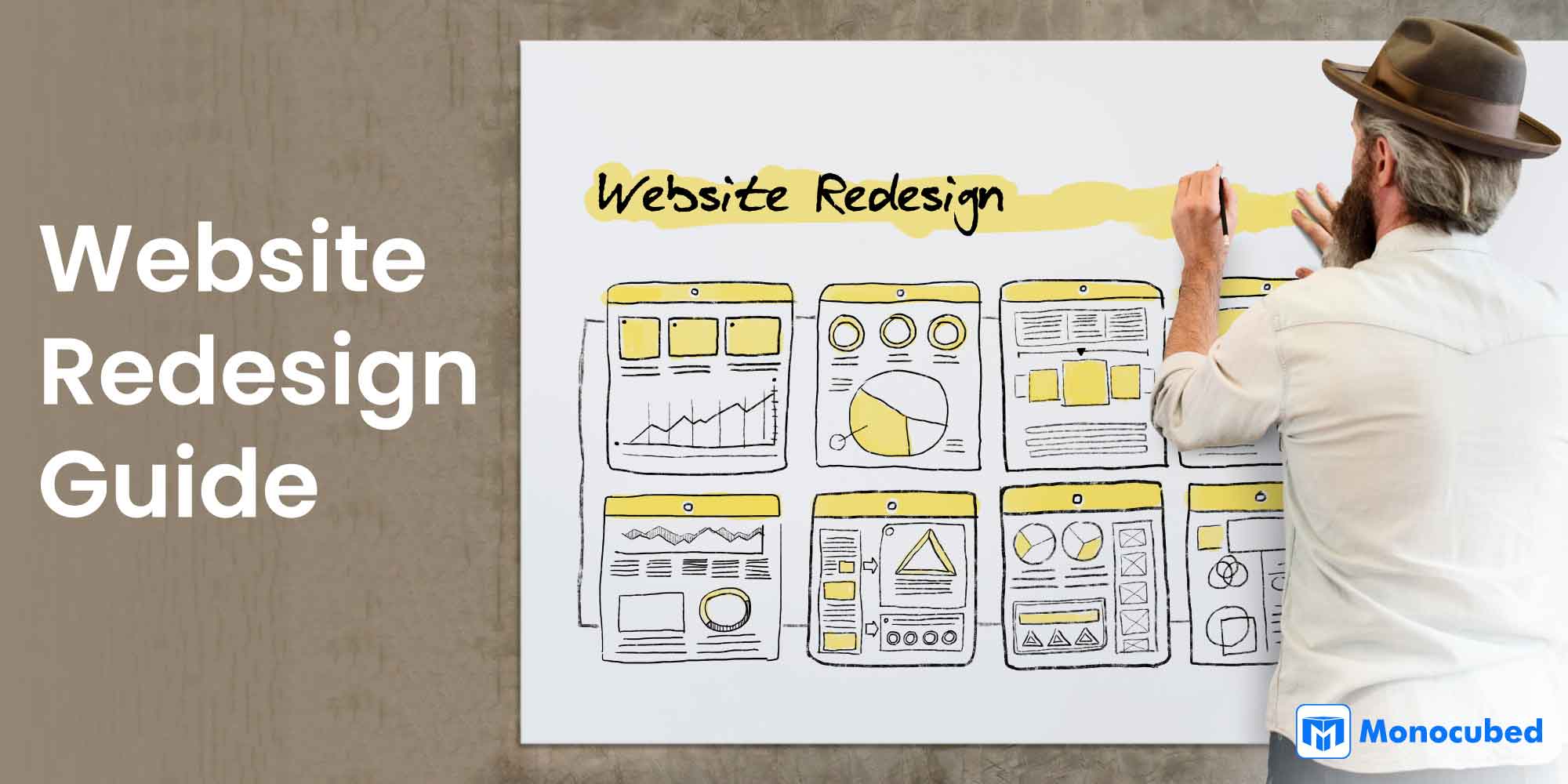In this comprehensive guide to website redesign, you will gain valuable insights into:
- Understanding Website Redesign: We’ll demystify the concept and importance of website redesign.
- Enhancing User Experience: Learn how a well-executed website redesign can significantly improve user experience, making navigation smoother and content more accessible.
- SEO Advantages: Uncover the SEO benefits of a well-planned redesign, including improved search engine rankings and mobile optimization.
Join us on this journey to unlock the full potential of your online presence through these crucial aspects of website redesign. Whether you’re a seasoned webmaster or new to the world of websites, this guide will equip you with the knowledge and strategies needed for a successful website overhaul.
Table of Content
- Understanding the Concept of Website Redesign
- 4 Important Factors to Consider in Website Redesign
- The Importance of Regular Website Updates [12 Key Points]
- The Impact of Website Redesign on User Experience
- Quick Tips for a Fast Website [Why + How]
- The Role of Website Redesign in Branding
- 5 SEO Advantages of Website Redesign
- The Financial Benefits of Website Redesign
- 10 Common Pitfalls in Website Redesign
- Redesign Your Website Today
Understanding the Concept of Website Redesign
Website redesign refers to the process of giving your website a fresh new look and feel while improving its functionality. It involves revamping the design, layout, and structure of your website to enhance its overall performance.
What is Website Redesign?
Website redesign encompasses a range of changes, from visual updates to technological enhancements.
- Increase Conversions: Are you looking to get more sales or sign-ups?
- Improve User Experience: The site should be easy and enjoyable to use.
- Align with Brand: Your site should match your company’s look and feel.
Goals and Objectives
Remember, website redesign is not a one-time event. It’s an ongoing process that requires regular updates to stay current and competitive. As a result, a good UI/UX can help companies align their brands, improve user experience, and increase conversions, proving to be a valuable lead generation strategy.
Looking to Redesign Your Website?
Contact us. Develop a user-friendly web app to attract maximum customers and increase your online business.
4 Important Factors to Consider in Website Redesign
Here are the 4 core factors to consider while redesigning the website.
- Visual Elements: One of the main goals is to update the visual elements of your website. This includes choosing a new color scheme, selecting modern fonts, and incorporating eye-catching graphics.
- Mobile Optimization: Another important aspect is making your website mobile-friendly. With the increasing use of smartphones and tablets, it’s crucial to have a responsive design.
- Navigation: Enhancing navigation is key. A well-designed menu can make it easier for visitors to find what they’re looking for.
- Latest Technologies: Incorporating the latest web technologies like HTML5 and CSS3 can add dynamic and interactive elements to your site.
The Importance of Regular Website Updates [12 Key Points]
Regular updates are crucial for several reasons. Here are the 12 key reasons
- Design Trends: What looked good a few years ago might look outdated now.
- Tech Advancements: New tools and coding methods can make your site work better.
- SEO Benefits: An updated site can rank higher in Google search results.
- Security: New vulnerabilities are discovered regularly. Updating your website’s backend ensures that you are protected against the latest known security threats.
- Performance: New technologies often offer improved performance. Faster load times, smoother animations, and other performance improvements can make a big difference in user experience.
- Features: New technologies also enable new features that weren’t possible before. Interactive elements, better mobile experiences, and AI integrations are just a few examples.
- Algorithm Updates: Search engines like Google frequently update their algorithms. Keeping your website updated ensures that you comply with the latest SEO best practices, helping you maintain or improve your search rankings.
- Content Relevance: Fresh, updated content is a signal to search engines that your website is active and offering current information, which can positively impact your SEO.
- Accessibility: Laws and guidelines around website accessibility are becoming stricter. Regular updates can help you stay compliant with accessibility standards like ADA.
- Privacy Policies: With increasing concerns about user data and privacy, keeping your privacy policy and data protection mechanisms updated is crucial.
- Fresh Content: Regularly updated content not only helps with SEO but also gives visitors a reason to come back.
- Bug Fixes: Nothing turns users away faster than a broken website. Regular updates allow you to fix bugs and issues that could otherwise harm user experience.
The Impact of Website Redesign on User Experience
User experience plays a pivotal role in the success of any website.
Why User Experience is a Big Deal?
User experience is super important. If your website is well-designed, people will stay longer and might even become customers. On the other hand, a poorly designed website can make people frustrated and they’ll likely leave. Just in case, if you are looking for features to add here is a blog about features of website.
- A good design keeps people around.
- A bad design drives them away.
Key Takeaways:
What to Focus On for a Great User Experience
There are three big things to think about when you’re redesigning your website:
- Making Navigation Easy
Navigation is super important. You want people to find what they need without getting lost or frustrated. This is all about how easy it is for people to move around your website and find what they’re looking for.
Why It’s Important: Imagine clicking on something and ending up somewhere totally different. That’s annoying, right? That’s why you need to make sure your navigation is clear and simple.
What You Can Do: Use menus that are easy to find and read. Put the most important stuff where people can see it right away.
Remember: Good navigation is like a good map. It helps people find what they’re looking for.
- Accessibility is for Everyone
Accessibility is all about making sure everyone can use your website, no matter what.This means making sure everyone, including people with disabilities, can use your site.
Why It’s Important: Some people need special features to browse the web. If your site doesn’t work for them, they’ll leave.
What You Can Do: Add things like text descriptions for images (those are called “alt tags”). Make sure people can navigate your site using just a keyboard.
Remember: A website that everyone can use is a website that can get more visitors.
- Speed Things Up
Nobody likes waiting. If your website is slow, people will leave. This is how fast your website loads and how smoothly it runs.
Why It’s Important: Slow websites are a big turn-off. If your site takes forever to load, people will go somewhere else.
What You Can Do: Make your website faster by doing things like making image files smaller. You can also use less code to make your site run faster.
Remember: A fast website is like a fast food delivery. It makes everyone happy.
Quick Tips for a Fast Website [Why + How]
Here are some quick things you can do to make your website faster:
- Optimize Images
Why? Large images take longer to load.
How? Use tools to compress images without losing quality. - Reduce Code
Why? Extra code can slow down your site.
How? Minimize the use of unnecessary CSS and JavaScript. Use tools to “minify” your code, removing any extra spaces or lines. - Leverage Browser Caching
Why? This lets visitors store parts of your site on their computer for faster loading next time.
How? Set up caching rules in your website’s settings or through plugins. - Use a Content Delivery Network (CDN)
Why? CDNs can serve your site from locations closer to the visitor.
How? Choose a reliable CDN provider and integrate it with your website. - Prioritize Above-the-Fold Content
Why? This ensures the content users see first loads quickly.
How? Load essential content first and delay less important content. - Reduce Redirects
Why? Each redirect slows down the page loading process.
How? Keep redirects to a minimum and ensure they’re truly necessary.
Remember: A faster website can lead to happier visitors and better search engine rankings.
The Role of Website Redesign in Branding
A well-executed website redesign can significantly elevate your brand and improve the overall user experience.
- Reinforcing Brand Identity
- Colors: Choose a color palette that aligns with your brand values and evokes the desired emotions. For example, blues often convey trust, while reds can evoke excitement.
- Typography: Select fonts that mirror your brand’s tone and voice. Serif fonts often appear more traditional, while sans-serif fonts are viewed as modern and clean.
- Imagery: Utilize images that create emotional connections and reflect your brand’s mission and values. This could range from product photos to team pictures to thematic illustrations.
- Logo and Favicon: Make sure your logo is prominently displayed, and use a corresponding favicon for browser tabs to enhance brand association and recognition. If you’re looking for options, consider exploring a free logo maker to create a unique and professional logo for your brand.
- Attracting and Retaining Customers
- Visual Appeal: Implement compelling visuals and layouts to capture attention immediately. High-quality images and a cohesive color scheme are key.
- User Experience: Enhance user engagement and increase conversions with clear navigation, responsive design, and quick load times.
- Content Quality: Provide valuable, informative content that solves problems or answers questions. This builds trust and establishes your brand as an authority. Leveraging unique content can be a practical way to ensure this quality while engaging a larger audience.
- Interactive Elements: Add interactive features like videos, quizzes, or interactive demos to keep visitors engaged longer.
- Social Proof: Incorporate testimonials, user reviews, or case studies to build credibility and trust, encouraging new visitors to become loyal customers.
- Interactive Engagement
- Interactive Elements: Add features like videos, quizzes, or interactive demos to keep visitors engaged longer.
- Calls to Action: Use persuasive CTAs to guide users towards desired actions like signing up for a newsletter or making a purchase.
- Building Credibility
- Social Proof: Incorporate testimonials, user reviews, or case studies to build credibility and trust.
- Certifications and Awards: Display any industry certifications, awards, or recognitions to further establish credibility.
- Aligning with Marketing Goals
- SEO Optimization: Ensure that the website is optimized for search engines to improve visibility.
- Analytics Integration: Integrate tools for tracking user behavior and conversions to measure the effectiveness of your marketing strategies.
- Lead Generation: During your website redesign, make sure to include elements designed for lead capture, like contact forms or newsletter sign-ups, to align with your marketing goals, especially if you’re aiming for LinkedIn lead generation. These features can play a crucial role in converting visitors into potential leads.
Rebrand Your Website Today
Upgrade your website that is feature-rich, scalable, and integrable with your existing system as per your requirements.
5 SEO Advantages of Website Redesign
Search engine optimization (SEO) is crucial for improving your website’s visibility and driving organic traffic. Utilizing conversion rate optimization tools during the redesign process presents an excellent opportunity to optimize your site for search engines, ensuring you rank higher in search engine result pages. Implementing content marketing in higher education as part of your redesign strategy can enhance your website’s authority, attract a more engaged audience, and improve search rankings.
- Boosting Search Engine Rankings
During a website redesign, you can optimize your website’s structure, meta tags, and keywords to align with the latest SEO best practices. By prioritizing SEO-friendly elements, you can boost your search engine rankings and increase organic traffic. - Optimizing for Mobile Devices
In today’s mobile-centric world, optimizing your website for mobile devices is essential. A responsive website design ensures that your site looks and functions seamlessly across various screen sizes, providing a positive mobile user experience. By integrating mobile optimization during a website redesign, you can appeal to a broader audience and improve your chances of driving conversions. - Enhancing User Experience for SEO
User experience (UX) is increasingly becoming a factor that search engines consider. A redesigned website that focuses on UX can lead to longer session durations and lower bounce rates, both of which can positively impact your SEO. - Content Relevance and Quality
Quality content is the cornerstone of good SEO. A redesign is the perfect time to update old content, remove what’s irrelevant, and add new, high-quality content that aligns with your target keywords. This not only helps in ranking but also provides value to your visitors, making them more likely to engage with your site. - Leveraging Technical SEO
Technical SEO elements like schema markup, XML sitemaps, and SSL certificates can be seamlessly integrated during a redesign. These elements help search engines understand your content better and can contribute to improved rankings.
By focusing on these five key areas during your website redesign, you can significantly improve your site’s SEO, thereby boosting its visibility and effectiveness in attracting and converting organic traffic.
The Financial Benefits of Website Redesign
Website redesign not only has aesthetic and user-focused advantages but also brings financial benefits to your business. By improving your website’s performance and conversion rates, you can achieve a substantial return on investment.
- Increasing Conversion Rates
A well-designed website can significantly impact your conversion rates. By implementing user-centric design elements, such as clear call-to-action buttons and persuasive content, you can guide visitors towards desired actions, such as making a purchase or filling out a contact form. This, in turn, increases your chances of converting leads into paying customers. - Reducing Website Maintenance Costs
An outdated website often requires frequent maintenance and fixes, leading to increased costs over time. Website redesign allows you to build a more robust and efficient website that requires minimal maintenance. By reducing maintenance costs, you can allocate your resources toward other critical business areas.
10 Common Pitfalls in Website Redesign
While the idea of redesigning your website may seem straightforward, there are common pitfalls that you should avoid:
- Ignoring User Feedback: Always consider the user experience and gather feedback before making drastic changes.
- Skipping Mobile Optimization: In today’s world, a mobile-friendly site is a must.
- Neglecting SEO: Failing to consider SEO can result in a drop in search rankings.
- Inconsistent Branding: A redesign should make your site more aligned with your brand, not less. Inconsistent fonts, colors, and messaging can confuse your audience and weaken your brand’s identity.
- Failing to Test on Multiple Browsers and Devices: Different browsers and devices can display your website differently. Failing to test your redesign on multiple platforms can lead to a poor user experience for a segment of your audience.
- Ignoring Page Load Speed: Users are likely to leave if your website takes too long to load. Ignoring page load speed during a redesign can negatively impact both user experience and SEO.
- Lack of a Rollback Plan: If things go wrong during or after the redesign, you’ll need a way to revert back to the old design. Failing to have a rollback plan can lead to extended downtime and lost revenue.
- Forgetting About Analytics: Not setting up analytics tracking from the start can result in a loss of valuable data. This data is crucial for understanding how the changes are affecting user behavior and SEO.
- Overlooking Content Strategy: Content is king, and a redesign can be the perfect time to audit and improve your content. Neglecting this step can result in missed opportunities for better engagement and SEO.
- Poor Call-to-Action Placement: Your calls-to-action (CTAs) should be clear and prominently placed. Poor CTA placement can lead to lower conversion rates.
Redesign Your Website Today
Website redesign offers numerous benefits for businesses looking to enhance their online presence. From improving user experience and search engine rankings to boosting brand identity and increasing conversion rates, website redesign can be transformative. By staying current with design trends and incorporating user-focused elements, you can uncover the true potential of your website, resulting in increased customer engagement and business growth.
 By Jeel Patel
By Jeel Patel



